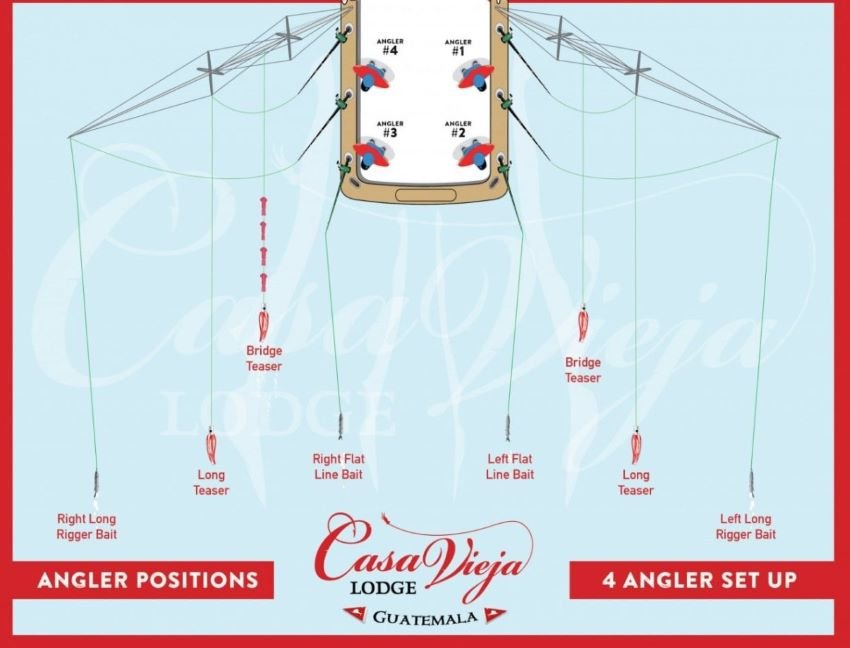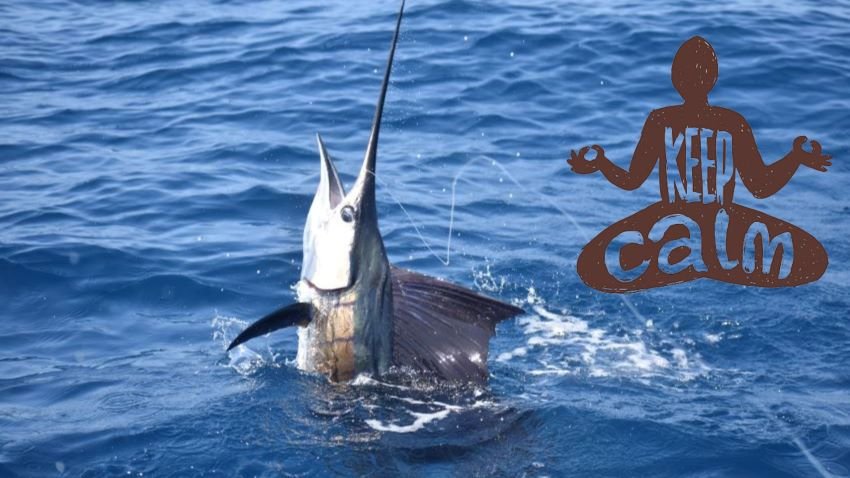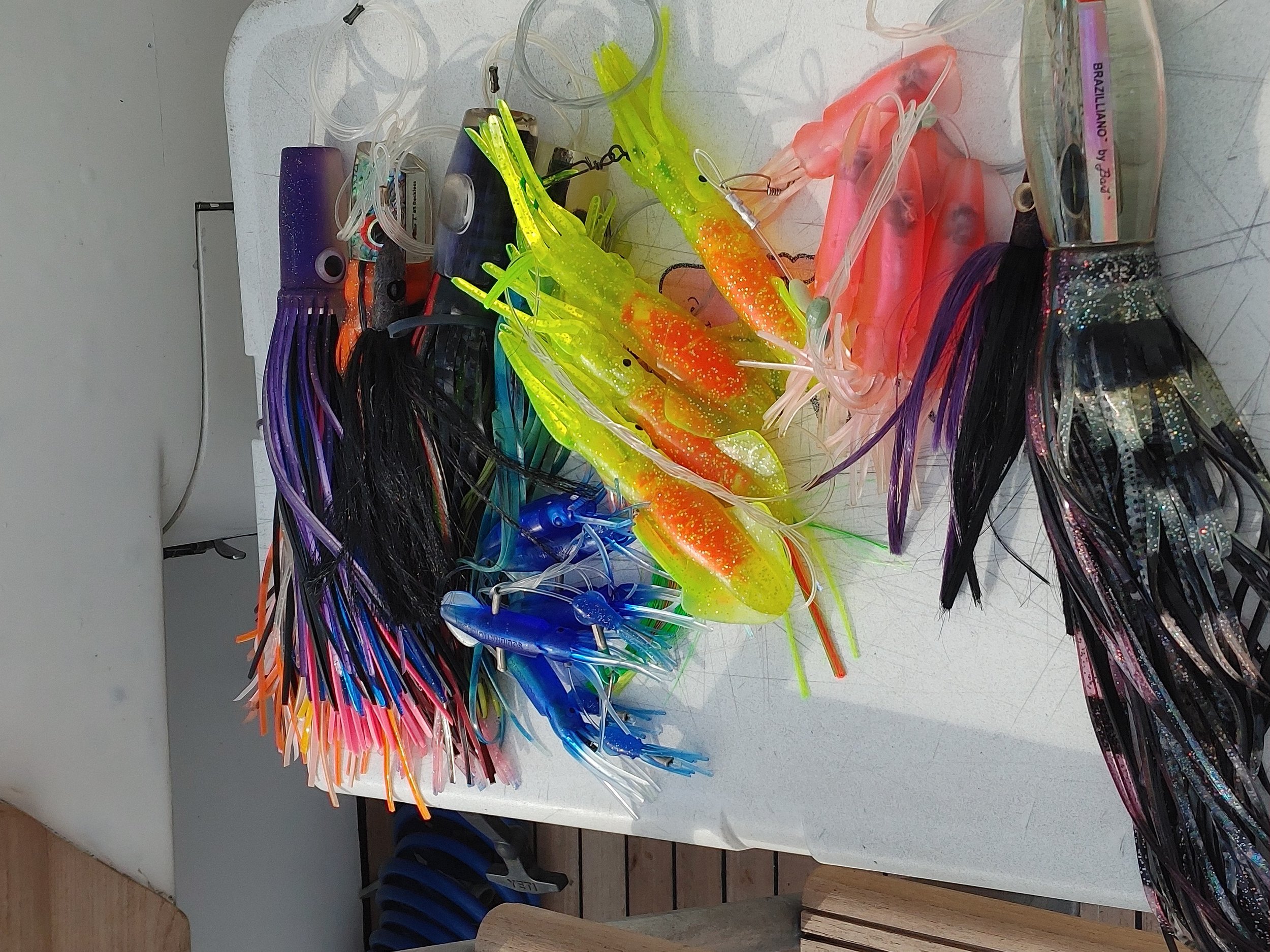Preparing for the Guatemala Bait-and-Switch
Lots of ardent anglers look down on trolling, believing that it’s a non-skilled, non-participatory way to fish. That keeps them from joining us on our trips to Guatemala, which in and of itself is a huge mistake. There are lots of situations where trolling is the most effective and even the most enjoyable way to spend all or part of a day on the water.
The great thing about trolling for sailfish is that you can be as involved as you want. The captains and mates at Casa Vieja Lodge are happy to instruct you, and also to let you take control of the “bait and switch” process. Alternatively, you can just reel in one sailfish after another. In all likelihood you’ll probably live somewhere in between those two extremes.
Lots of experienced billfish tournament anglers visit CVL for their preseason tune-ups: They’ll get plenty of shots at fish, and the occasional flub outside of competition will get the jitters out for when money’s on the line. If it’s your first billfishing trip, you might be wondering what’s so hard about the process. Here’s what I’ll tell you: No matter how many times it’s explained to you, or how clearly you understand, when a fish is in the spread your brain will turn into a vat of mashed potatoes. The key is to work to slow everything down in your thought process – and not to get too worked up if and when you miss a catchable fish.
What Is the Bait and Switch?
When you arrive at the fishing grounds, the mates will put out eight total lines, four on each side of the boat. Six of those eight (three on each side) will be affixed to an outrigger to spread them out. Two on each side will have hooks and two will be purely teasers. The action of the lures/baits, as well as the harmonics of the boat, will draw fish up into the buffet. Sometimes they’ll eat the baits with hooks in them – in which case you’ll feed them line until they turn, and then engage the reel for the fight. If, however, the fish comes up on one of the teasers, you will either need to pull a bait up to it or drop a bait back to it. The sailfish will often be in a fury, with their bills acting like windshield wipers above the surface. As your hooked bait moves toward the teaser, the mate will move the teaser away, so now their only option is the one that will sting them.
Diagram courtesy of Casa Vieja Lodge
Is The Spread Always the Same?
The basic setup has always stayed the same during our trips to CVL, although the mates will experiment with different shapes, sizes and colors of teasers (including the daisy chain of squid imitators) if the fish aren’t reacting aggressively. However, the spread takes an altogether different shape for flyrodders. Because the casting motion takes up more space than a simple pitch bait, they can only have the outrigger extended on one side of the boat. As seen in the diagram from CVL, below, they’ll run three teasers on that side and one or none on the other side. The goal is to make the fish eat sideways or going away, which requires some casting flexibility – even if the average cast isn’t that long.
How Do You Prepare for Sailfish in the Spread?
It may be second nature for the longtime billfish anglers, or if you’re simply a natural, but as I noted above, if it’s your first time you may get weak in the knees. You’ll troll for a while with no results, start to get complacent, and then suddenly it’s the world’s craziest fire drill. Here are my three steps that will help you prepare:
Ask your captain and/or mate/s for a full explanation of how the process works. Most of them speak very good English and they are experienced teachers. They want you to do well, and will go above and beyond the call of duty to make that happen. If you don’t understand, ask again.
For the first couple of fish, I strongly recommend letting the mate/s handle the bait and switch process. They will make it look remarkably easy, but remember that they’ve done it hundreds if not thousands of times. They’re professionals and it shows. The path to working on a boat at CVL is not a fast or easy one.
If you still don’t understand, ask more questions.
When it’s your turn to drop a bait back or pull one forward, dumb it down in your own mind. The Captain will call out “Left short teaser” or “Right long rigger” or some other combination. In the excitement of the moment, just focus on two binary decisions: Left or right and long or short. That’ll cut the guesswork as to where you need to move down substantially.
Do You Need Any Special Gear?
Casa Vieja has the best of the best when it comes to rods and reels and the appropriate selection of teasers. They get high quality bait every day, too. Still, it’s helpful to let the gear you bring or use make you into a success.
Good polarized sunglasses which block out the sun from the sides will help. While the captain’s calls from the tower will guide your movement, it’ll be even cooler and more natural if you spot the fish in the spread (especially if you’re good enough to see it before anyone else). Sometimes it’s flat and they come in with bills slashing above the water and you can’t help but see them, and other times it’s a lot tougher. If you’re anything like me, you’ll occasionally see a “sailfish mirage,” too.
The rigged ballyhoo that the lodge uses for baits are all on circle hooks. For those of us used to bass fishing, where the goal is to “cross their eyes,” that can present problems. Here, once you know the fish has the bait you need to effectively free spool the reel (allowing them to take line without resistance, while not letting the reel backlash) for a count of five. Then you aim the rod forward and wait for the line to come tight. Done properly, the hook will seat in the corner of the mouth every time.
Advice on How to Maximize Your Opportunities and Fun
Again, I strongly recommend that you let the mates show you the proper technique – allowing them to handle the process on the first few fish. Also, ask lots of questions. They’d rather you ask and then do things right than fail for no reason at all.
After you take a turn at the bait and switch, whether you’re successful or not, ask the captain, mates, or even your similarly-inexperienced boatmates, what they saw and how you could improve.
Remember that sailfish often travel in packs – we’ve had tons of doubles and a few triples, so it often pays to keep working the process even after one is tempted or hooked.
Some of the boats have one mate and others have two — this may affect your need to participate.
Other Notes
I can’t stress enough how good the staff at the lodge is at this process. They make it look simple, and your numbers will invariably be better if you let them handle everything. If that satisfies you, it’s your trip and that’s fine. If you’d rather be more hands-on, however, don’t fixate on numbers. No one is judging you. It’s all about what you want to get out of the process. As owner/captain David Salazar told us: “This is your trip. Do it the way YOU want.”
Casa Vieja holds what they call their “No Sancocho” tournament each year. In this tournament you and your teammates will be required to do the entire bait, switch and fight by yourselves. You will be awarded points based on certain levels of difficulty: marlin and sailfish released; and also the type of gear used (fly, 50 lb. or 30 lb.). Making it even more fun or stressful, depending on your point of view, “every missed bite costs anglers $20. Money from every missed bite, or sancocho is then donated to a local school in Puerto San Jose.”











